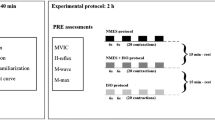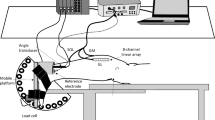Summary
This study aimed to assess the effects of training using electrical stimulation (ES) on the contractile characteristics of the triceps surae muscle. A selection of 12 subjects was divided into two groups (6 control, 6 experimental). The ES sessions were carried out using a stimulator. Flexible elastomer electrodes were used. The current used discharged pulses lasting 200 μs at 70 Hz. Contraction time was 5 s and rest time 15 s. The session lasted 10 min for each muscle. Training sessions were three times a week for 4 weeks. Biomechanical tests were performed using an isokinetic ergometer. Subjects performed plantar flexions of the ankle over a concentric range of movement at different angular velocities (60, 120, 180, 240, 300, 360°·s−1) and held isometric contractions for 5 s at several ankle flexion angles (−30/−15/0/15°−0 corresponded to foot flexion of 90° relative to the leg axis). The force-velocity relationship was seen to shift evenly upwards under the influence of ES (P<0,05). The increased force during the “after” test was greater (P<0,05) for ankle angle positions of 15° and −30°, which demonstrated a link between the training angle and the gain in strength. No change was noted in the cross-sectional area of the muscle. The results showed that ES allowed the contractile qualities of muscle to be developed in isometric and dynamic conditions. Nervous mechanisms can account for most of these adaptations.
Similar content being viewed by others
References
Bobbert MF, Schenau JI (1990) Isokinetic plantar flexion: results and model calculations. J Biomech 23:105–119
Close RI (1972) Dynamic properties of mammalian skeletal muscles. Physiol Rev 52:129–197
Davies CTM, Dooley P, McDonagh MJN, White MJ (1985) Adaptation of mechanical properties of muscle to high force training in man. J Physiol 365:277–284
Duchâteau J, Hainaut K (1988) Training effects of electrostimulation in human muscle. Med Sci Sport Exerc 20:99–104
Eriksson E, Haggmark T, Kiessling KH, Karlsson J (1981) Effect of electrical stimulation on human skeletal muscle. Int-I Sports Med 2:18–22
Erlanger J, Gasser HS (1937) Electrical signs of nervous activity. University of Pennsylvania Press, Philadelphia, p 80
Goubel F, Marini JF (1987) Fibre type transition and stiffness modification of soleus muscle of trained rats. Pflügers Arch 410:321–325
Gransberg L, Knutsson E (1983) Determination of dynamic muscle strength in man with acceleration controlled isokinetic movements. Acta Physiol Scand 119:317–320
Gravel D, Richards CL, Filion M (1988) Influence of contractile tension development on dynamic strength measurements of plantarflexors in man. J Biomech 23:89–96
Gregor RJ, Edgerton VR, Perrine JJ, Campion DS, Debus C (1979) Torque-velocity relationships and muscle fiber composition in elite female athletes. J Appl Physiol 47:388–392
Grive DW, Pheasant S, Cavanagh PR (1978) Prediction of gastrocnemius length from knee and ankle joint posture. In: Asmussen E, Jorgensen K (eds) Biomechanics VI-A (International series on biomechanics, vol 2A) University Park Press, Baltimore, 405–412
Hill AV (1938) The heat of shortening and the dynamic constants of muscle. Proc Roy Soc B 126:136–195
Hill AV (1970) First and last experiments in muscle mechanics. University Press, Cambridge, pp 1–141
Hultman E, Sjöhohn H, Jäderholm-Ek I, Krynicki J (1983) Evaluation of methods for electrical stimulation of human skeletal muscle in situ. Pflügers Arch 398:139–141
Kanda K, Burke RE, Walmsey B (1977) Differential control of fast and slow twitch motor units in the decerebrate cat. Exp Brain Res 29:57–74
Kovanen V, Suominen H, Heikkinen E (1984) Mechanical properties of fast and slow skeletal muscle with reference to collagen and endurance training. J Biomech 17:725–735
Kubiak RJ, Whitman KM, Johnston RM (1987) Changes in quadriceps femoris muscle strength using isometric exercise versus electrical stimulation. J Orthop Sports Phys Ther 8:537–541
Lindh M (1979) Increase of muscle strength changes from isometric quadriceps exercise at differents knee angles. Scand J Rehabil Med 11:33–36
Miller S, Mirka A, Maxfield M (1981) Rate of tension development in isometric contractions of human hand muscle. Exp Neurol 73:267–285
Mortimer JT (1981) Motor prostheses. In: Brooks VB (ed) Handbook of physiology, section 1. The nervous system, vol. II, Motor control I, American Physiological Society, Bethesda
Niyagaard E, Houston M, Suzuki Y, Jörgensen K, Saltin B (1983) Morphology of brachial biceps muscle and elbow flexion in man. Acta Physiol Scand 117:287–292
Nobbs LA, Rhodes EC (1986) The effect of electrical stimulation and isokinetic exercise on muscular power of the quadriceps femoris. J Orthop Sports Ther 8:260–268
Owens J, Malone T (1983) Treatment parameters of high frequency electrical stimulation as established on the electrostim 180. J Orthop Sports Phys Ther 4:162–168
Pousson M, Pérot C, Goubel F (1991) Stiffness and fibre type transitions in rat soleus muscle produced by jumping training. Pflügers Arch 419:127–130
Rajtsin L (1974) The effectiveness of isometric and electro-stimulated training on muscle strength at different joint angles. Yessis Rev 11:35–39
Rugg SG, Gregor RJ, Mandelbaum BR, Chin L (1990) In vivo moment arm calculations at the ankle using magnetic resonance imaging (MRI) J Biomech 5:495–501
Sale DG (1988) Neural adaptation to resistance training. Med Sci Sports Exerc 20:135–145
Selkowitz DM (1985) Improvement in isometric strength of the quadriceps femoris muscle after training with electrical stimulation. Phys Ther 65:186–196
Siff M (1990) Applications of electrostimulation in physical conditionning: a review. J Appl Sport Sci Res 4:20–26
Singer B (1986) Functional electrical stimulation of the extremities in the neurological patient: a brief review. Aust J Physiother 33:33–42
Taylor NAS, Sanders RH, Howick EI, Stanley SN (1991) Static and dynamic assessment of Biodex dynamometer. Eur J Appl Physiol 62:180–188
Thepaut-Mathieu C, Van Hoecke J, Maton B (1988) Myoelectrical and mechanical changes linked to length specifity during isometric training. J Appl Physiol 64:1500–1505
Thorstensson A, Grimby G, Karlsson J (1976) Force-velocity relations and fibre composition in human knee extensor muscle. J Appl Physiol 40:12
Tihanyi J, Apor P, Fekete Gy (1982) Force-velocity-power characteristics and fiber composition in human knee extensor muscles. Eur J Appl Physiol 48:331–343
Wickiewicz TL, Roy RR, Powel PL, Perrine JJ, Edgerton VR (1984) Muscle architecture and force-velocity relationships in humans. J Appl Physiol Respir Environ Exerc Physiol 57:435–443
Yates JW, Kamon E (1983) A comparison of peak and constant angle torque-velocity curves in fast and slow-twitch populations. Eur J Appl Physiol 51:67–74
Author information
Authors and Affiliations
Rights and permissions
About this article
Cite this article
Martin, L., Cometti, G., Pousson, M. et al. Effect of electrical stimulation training on the contractile characteristics of the triceps surae muscle. Europ. J. Appl. Physiol. 67, 457–461 (1993). https://doi.org/10.1007/BF00376463
Accepted:
Issue Date:
DOI: https://doi.org/10.1007/BF00376463




